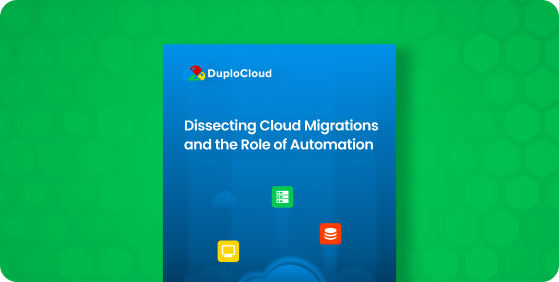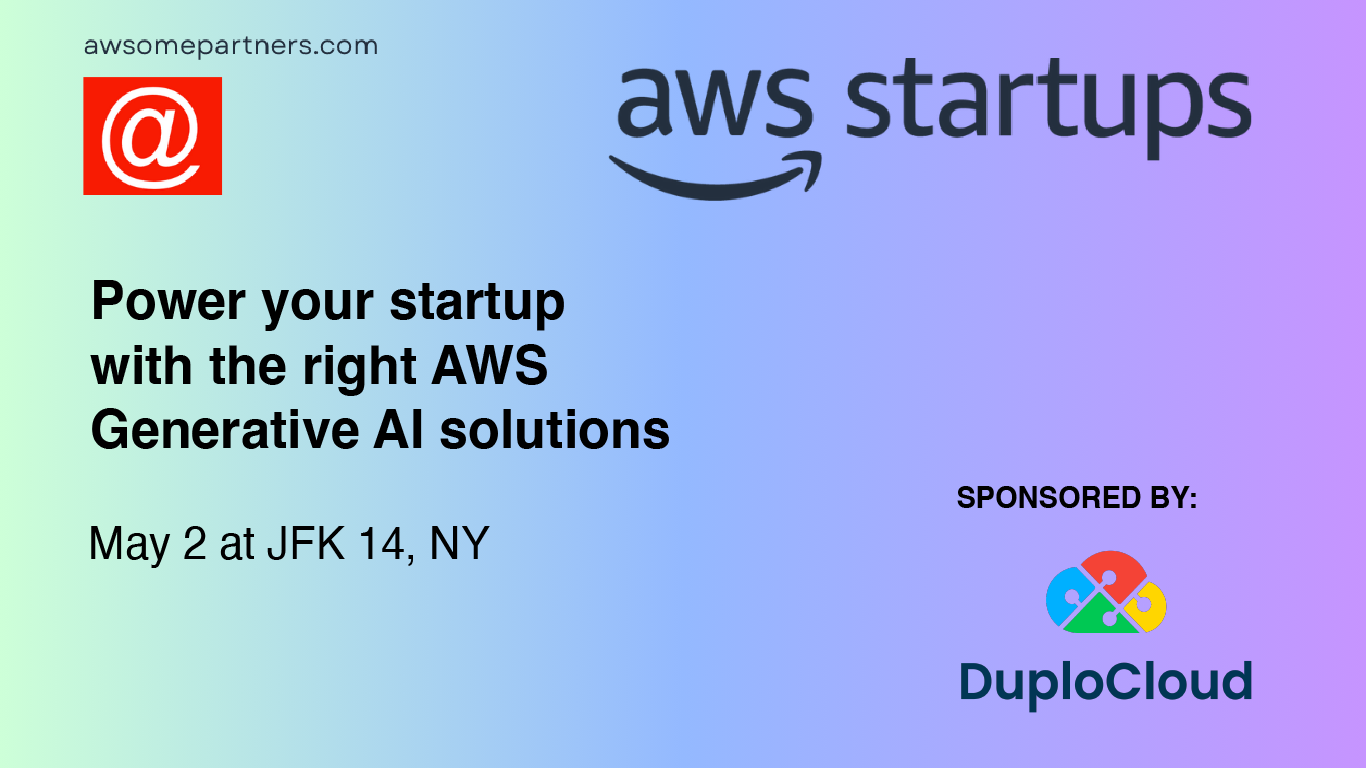Embarking on a cloud migration is a strategic necessity, requiring a blend of cloud computing knowledge with the expertise of DevOps and SecOps teams. Cloud Migrations offer multiple paths, each offering performance, cost, and control benefits. Occasionally, an organization may opt for a straightforward "lift and shift" approach, moving existing systems directly into the cloud. In contrast, more commonly, more complex methods necessitate rehosting some or all aspects of your architecture within a cloud environment.
Here are the three common approaches to cloud migration, each with its pros and cons:
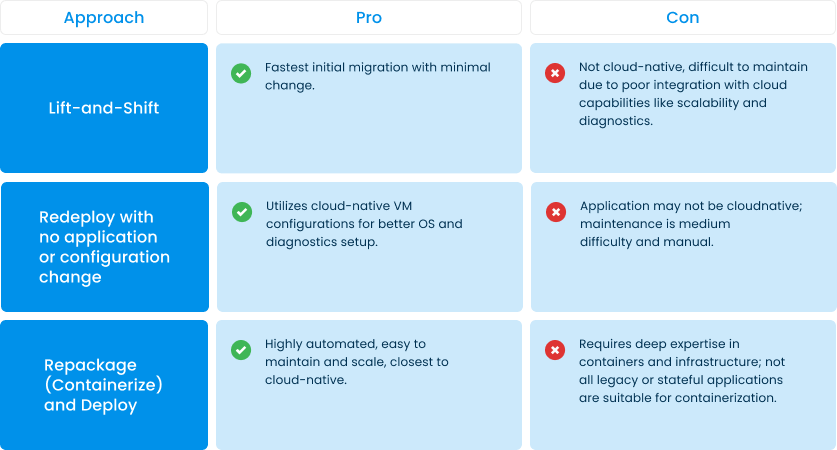
This transformation goes beyond mere technical implementation - it's about aligning your migration strategy with your business goals. Our eBook will guide you through common challenges, providing clear, authoritative insights to navigate the complexities of cloud migration efficiently. Here, you'll discover the approaches DuploCloud will take for any organization, ensuring a successful transition to the cloud.
Specific Cloud Migration Pain Points
Cloud migration presents a landscape rich with possibilities, thanks to the sophisticated offerings of cloud service providers. From storage, compute, and networking to managing security groups, containers, clusters, and databases, the options for building your cloud architecture are nearly limitless. However, the technical challenges needed to manage these options can seem overwhelming.
Navigating through a cloud migration often uncovers significant challenges, including:
Skill Gaps
A move to the cloud requires knowledge of cloud infrastructure and DevOps. Many organizations can identify deficiencies within their current infrastructure setup, but often they need help knowing how or where to begin their analysis. The initial step often involves a thorough skills assessment to identify gaps.
Tech Gaps
A shift to the cloud may encourage your organization to re-evaluate your technological foundation. Challenges may exist when identifying technical gaps and creating a plan to address them. Addressing technical infrastructure gaps can affect interoperability, compromise data security, and compliance standards, and generate volatility or downtime.
End Customer Experience
Ensuring that your migration runs smoothly is paramount for business operations. You must strategize to ensure that migration does not negatively impact sales and the customer experience. This includes minimizing downtime and ensuring that data migration is seamless.
Resource and Time Allocation
Planning for a migration may bring a fear that the project will incur unplanned costs in resources and staffing. You may wonder how much time your engineers will need to spend on the migration instead of their usual duties. You may also wonder how much of your existing code will need to be modified or if your security and compliance settings will be affected.
Moving your infrastructure to the cloud requires knowledge of the cloud and the knowledge to manage each complex service and monitor it as your system goes live. Even a lift-and-shift approach may present some challenges if your developers or operations team doesn’t have the necessary background in managing cloud-based infrastructure. Addressing these pain points requires a calculated approach, blending strategic planning with the right expertise to ensure a migration that is not only smooth but also aligns with your organization's broader goals.
Finding a Solution
This is where DuploCloud provides an alternate option. DuploCloud provides both the platform and in-depth support from a team of Solution Architects, DevOps Engineers, and Technical Operations Engineers. This means your DevOps solution is unique to your business model.
DuploCloud achieves a high level of customization through three stages of DevOps deployment, guiding you as much as you need along the way.
DuploCloud’s team of DevOps automation experts provides step-by-step support throughout the entire migration process. We analyze your infrastructure and architecture and take the lead in making your application cloud-ready. We flag common pitfalls throughout the process and provide solutions to ensure a smooth transition to the cloud. Our risk analysis and mitigation strategies are essential to ensure a move to the cloud won't disrupt business operations or put you over budget.
With the combination of DuploCloud's platform and team of experts, we have enabled hundreds of businesses to successfully modernize and optimize their infrastructure as part of their cloud migrations.You are assured of an effective, realistic, executable migration plan using automated management and migration tools with specialized DevOps and SecOps skills.

Storage, Compute, Network
At the core of the cloud migration decision is determining the best solution for storage, compute, and networking services.
Beyond these services, each of the three major cloud hosting (AWS, GCP, Azure) providers offer hundreds of services to manage everything from container orchestration to database querying to triggering failure alerts. Before you move to the cloud, you need to have a handle on your existing architecture and identify all the services you need to replicate or enhance in your tech stack in the cloud. This is another way DuploCloud supports you through all stages of a migration.
The Three Core Stages of DuploCloud’s Cloud Migration
DuploCloud ensures a seamless transition to the cloud through automation and subject matter expertise. Our implementation lead will work with you to provide support long before your cloud migration begins. Once your architecture and platform are decided upon, we can provide any needed customization as we progress through our cloud migration journey.
The core phases of DuploCloud’s cloud migration are Assessment and Planning, Setup and Training, and Production Readiness and Cutover — we also cover Post-Cloud Migration Support.
Phase #1 - Assessment and Planning
During the first phase, DuploCloud requests access to your existing infrastructure and performs an offline audit. Then, DuploCloud partners with your application, software engineering, and/or technical operations team to better understand your current application environment and compliance goals.
To better understand your current environment, DuploCloud reviews:
- Current coding language(s)
- Any containerization solutions used
- Application data flow
- Dependencies within the environment (e.g., third-party tooling)
- The makeup of current engineering team
DuploCloud ensures that any proposed solutions align with your business objectives and actively works to understand your higher-level requirements. Additionally, your onboarding team reviews all your existing software, hardware, microservices, and security needs to draw out a high-level application architecture. DuploCloud aims to understand your systems well enough to deliver pre-built options.
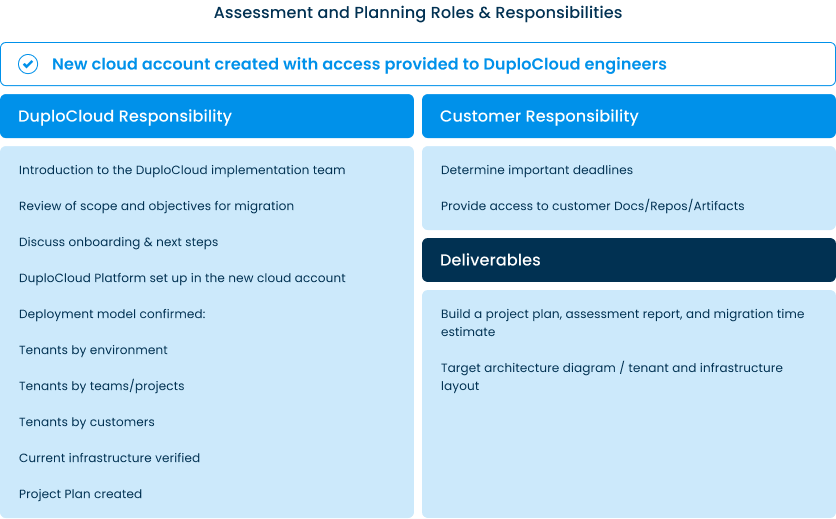
Once the necessary information is compiled, the Solutions Architect will perform an analysis and present the following data:
- A list of risk areas that need to be addressed. These changes may need to be made to your application or environment in preparation for migration.
- A project plan. The plan provides a step-by-step migration path for each application and environment.
- A data migration plan. While your engineering team will need to perform the actual data migration, we will provide you with steps to ensure that data migration occurs safely.
- A cost analysis. The analysis will cover the estimated spending you will incur after migration. You can compare this to your current spending to calculate your ROI using DuploCloud.
Ultimately, the Assessment and Planning phase allows DuploCloud to determine the most effective level of help needed to make your use of DuploCloud sustainable and scalable. The tools provided allow you to calculate how much time your engineering team will devote to ensure the migration occurs on time. Our engineers will work with you to keep things on track and provide you with guidance, if needed, throughout the process.
Phase #2 - Non-Production Cutover / POC
Once your architecture has been designed and approved, you move into the Setup and Training phase. During the setup portion of this phase, infrastructure configuration begins, and recommendations for maximizing automation and optimizing performance are made.
As we create your infrastructure, we keep in mind four guiding principles:

With these principles at the forefront of all our decisions, we spin up the resources necessary to host your application in your chosen cloud provider. We then work with your engineering team, guiding any changes that may need to be made to become cloud-ready. Once this is done, we will pair with your engineers to manually deploy the application onto the aforementioned infrastructure.

Once your application has been deployed into a development environment, you can validate and sign off on it and, if desired, create a QA environment. Once everything is validated, DuploCloud will integrate your existing CI/CD process—or create a new one—for each environment created. Since DuploCloud identifies your specific requirements in the Assessment phase, we can integrate all of the services you need into your infrastructure configuration and deployment pipeline.
Finally, various logging, monitoring, and alerts can be integrated into your infrastructure. Depending on your requirements, several standalone and AWS, Azure, or GCP services can be used to provide alerts about your workload.
Phase #3 - Production Readiness and Cutover
After all the non-production environments are in place in the DuploCloud platform, you move into the Production Cutover phase, where we work with you to deploy and cutover your production environment. DuploCloud will do the heavy lifting here, in conjunction with your engineers. You must answer questions pertinent to the cutover, perform tests and QA, and perform your data migration. DuploCloud will only touch your data if it is closely tied to the infrastructure.
During this process, the Implementation Lead will work with your engineers to conduct any final testing and adjustments necessary to ensure everything is configured correctly and ready for deployment.
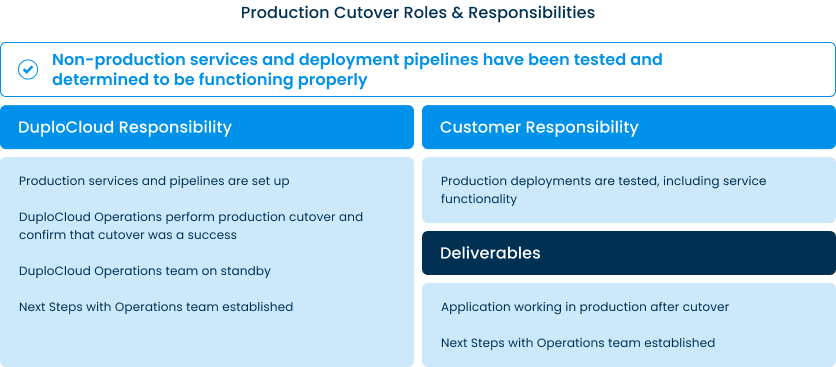
Once the Implementation Lead and your engineers are confident everything is good, we work with you to plan your production launch. We help you choose tools and a timeline for reducing DNS TTLs, handling "apex" domains, migrating databases and other data storage resources, and increasing cloud provider limits to support your use case.
After everything is determined to be ready for cutover, your application should experience little to no downtime, and end users should not notice any changes.
We will consider the onboarding a success once you have cutover and you have verified everything is working properly. After onboarding, our Operations team will continue to provide you with guidance and support, just as an in-house DevOps engineer would.
Post-Cloud Migration Support
Once migration is complete, you will have working sessions with the DuploCloud Operations team. Typically this manifests in a weekly cadence where DuploCloud engineers will meet to ensure things are progressing smoothly.
You also have access to Post-Migration QA support, including maintenance, product updates, vulnerability patches, pen testing, and are set up to receive interactive audits, ongoing monitoring, and alerts.
The DuploCloud Operations team is responsible for providing you with support and guidance during any compliance audits.
The DuploCloud Platform + On-Demand Expertise
As part of the end-to-end service offered by DuploCloud, you are supported long after your migration is complete. We achieve this through your DuploCloud platform and your access to an on-demand team of experts who provide decades of cloud experience.
Once your migration is complete, you can access your app deployment, cloud services, CI/CD pipeline, and monitoring and alerting services via the DuploCloud platform. Your platform is a no-code web interface. However, teams with more DevOps experience can use DuploCloud’s low-code Terraform provider and API.
Your DuploCloud service optimizes the performance of your cloud infrastructure by analyzing and fine-tuning various parameters long after your migration is complete. Parameters are defined as part of DuploCloud’s services, ensuring that your platform monitors your application for your specific needs.
The DuploCloud team offers guidance on anything related to cloud infrastructure, compliance controls, audits and IT questionnaires via 24/7 Slack access for the duration of your contract term.
While your initial setup includes security and compliance monitoring, DuploCloud provides security solutions for our partnership. DuploCloud includes implementing auto-generated controls within your DevOps workflow. Additionally, the DuploCloud platform ensures 90% compliance with the security and compliance controls set during your initial migration.
Ultimately, DuploCloud provides access to decades of cloud experience and expertise embedded in your DevSecOps solution. We work to tailor the system to each organization’s unique requirements. Instead of pushing our solution to fit into your environment, we do the opposite. We build your solution for your needs and maintain a flat rate to get your job done.

A Complete Solution
Whether your company needs to build a new DevOps product or work with anything in DevOps, DuploCloud is the team to help. You may have a growing startup that needs to build new microservices. Or you may need to set up regions to remove latency. Or you can test and develop data pipelines and use machine learning. Anything you’d like to do at the product level is going to have an impact on the DevOps team. And the good news is that it is all within DuploCloud’s scope.





